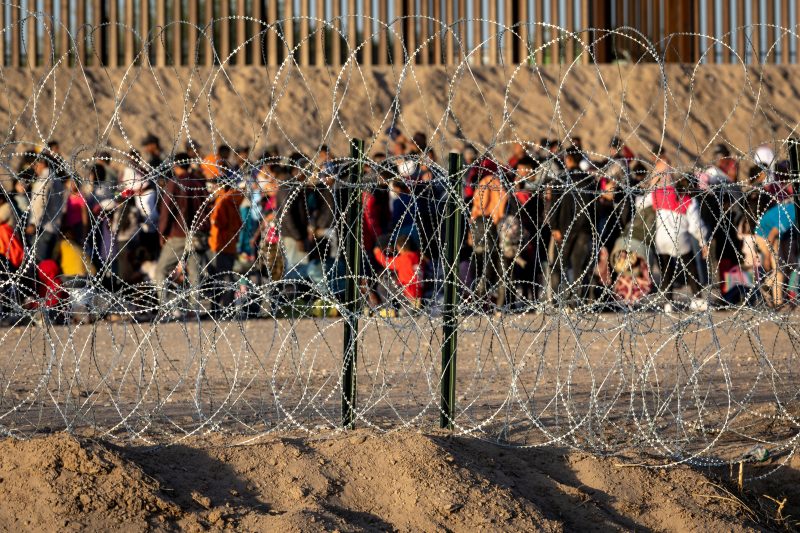The Biden administration is mobilizing U.S. troops and preparing to implement sweeping new asylum restrictions when the border expulsions carried out under a Title 42 pandemic policy cease this week, senior administration officials said Wednesday.
The expulsions, imposed by the Trump administration in March 2020 as the coronavirus gripped the nation, will end at 11:59 p.m. Thursday when the public health emergency expires.
New restrictions on asylum seekers will take effect the same day that will make it far easier for the government to deport migrants if they cross the border illegally or do not seek protection in other countries they travel through to reach the United States, Secretary of Homeland Security Alejandro Mayorkas told reporters.
Mayorkas described the measures — which have been widely denounced by immigrant advocacy groups — as an unpalatable but necessary component of a broader plan to offer more opportunities for migrants to reach the United States legally while cracking down on those who enter unlawfully.
“Our plan will deliver results,” Mayorkas said Wednesday at a news conference in Washington. “They will take time for those results to be fully realized. And it is essential that we all take this into account.”
U.S. authorities tallied more than 10,600 illegal crossings Tuesday, the highest one-day total ever, according to CBP data obtained by The Washington Post. The influx has left holding facilities and detention cells stretched beyond capacity, and officials expect the numbers to surge higher once Title 42 border policy expires.
“We are clear-eyed about the challenges we are likely to face in the days and weeks ahead, which have the potential to be very difficult,” Mayorkas said.
What happens after the Title 42 policy ends?
1/3
End of carousel
State Department and Department of Homeland Security officials told reporters their strategy is to deter illegal crossings on the border, deport those who are ineligible for protection and work with other countries to welcome migrants who apply to get in legally.
The U.S. government has carried out more than 2.7 million border expulsions under the Title 42 policy, often sending migrants back into Mexico to try again. Migrants say they are fleeing poverty and repression in countries such as Venezuela. The expulsion policy carried no legal consequences for attempting to reenter multiple times.
That will change starting Friday, officials said.
The end of the Title 42 policy means the return of Title 8, the federal law that deals with immigration processing.
Now, migrants who attempt to cross the border will be prohibited from reentering the United States for at least five years and subject to criminal prosecution for reentering the country without permission, officials said.
Officials also published a new emergency rule Wednesday restricting asylum starting Thursday. Federal law allows anyone who sets foot on U.S. soil and expresses a fear of returning to their home country for specific reasons, such as their political opinion, to apply for humanitarian protection. The new rule will presume that migrants are ineligible for asylum if they had traveled through another country where they could have sought protection instead. The rule aims to control mass migration after the expulsion policy and will expire after two years.
Advocates for immigrants say the new rule violates federal law, which says foreign nationals on U.S. soil may claim asylum if they fled persecution based on their race, religion, nationality, political opinions or membership in a “particular social group,” such as people targeted by gangs.
Officials said exceptions will be made for urgent cases, but advocacy groups are expected to challenge the new rule in court.
“It’s really sending this message that we can trade away the right to asylum in order to effectuate some border policies,” Blaine Bookey, legal director and adjunct law professor at the Center for Gender & Refugee Studies at the University of California College of the Law at San Francisco, said in a telephone interview. “It’s really peddling this narrative that seeking asylum at our border is not legal. The law is very clear.”
Mark Hetfield, president and chief executive of HIAS, a longtime refugee-resettlement agency, said the Biden administration’s scramble is the latest example of a decades-long failure by Congress and the executive branch to prepare for an inevitable influx of asylum seekers from impoverished and unstable countries. He said the federal government has heavily invested in enforcement to secure the border, but failed to hire enough judges and asylum officers to quickly hear migrants’ asylum claims.
He said the short-term solutions such as requiring asylum seekers to seek refuge in struggling countries is unrealistic.
“To expect someone to seek protection in a country where they can’t protect their own people is absurd,” he said. “We know that people are fleeing violence and are fleeing for their lives.”
Among other plans for the end of the Title 42 policy announced this week:
The Biden administration has said it will send another 1,500 troops to the Mexican border to join the 2,500 National Guard troops already there to aid U.S. Customs and Border Protection with surveillance and data entry. The first set of troops will head to El Paso on Wednesday, officials said. The troops will join asylum officers, medics and 24,000 Department of Homeland Security officers and agents in managing the expected influx.Officials said they will open the first “regional processing centers” in Colombia and Guatemala to direct migrants to legal pathways into this country and possibly others. The State Department said it eventually plans to open about 100 regional processing centers throughout the Western Hemisphere. Officials did not say which other nations might host the centers, nor how they would be funded.In coming days, officials will launch a new online platform for migrants to make appointments to arrive at a center, where more than 140 Homeland Security and State Department officials, working with the United Nations High Commissioner for Refugees and the International Organization for Migration, will direct migrants to refugee resettlement in the United States or other pathways into this country, Canada or Spain.CBP and Immigration and Customs Enforcement, both Department of Homeland Security agencies, will expand enforcement. CBP this week opened a pair of new holding facilities and ICE will add 5,000 beds and expand deportation flights. Health and Human Services is also increasing its capacity to shelter unaccompanied migrant children and teens, who have been crossing the border in record numbers.On Wednesday, officials will transition the troubled CBP One app to a new appointment scheduling system that will give migrants more opportunities to schedule an appointment, with priority given to those who have waited the longest.
The measures are in addition to past efforts to discourage mass migration, including doubling the number of refugees to be accepted from the Western Hemisphere, sending U.S. authorities to the Darien Gap to prevent migrants from being smuggled through the jungle between Colombia and Panama, and accepting up to 30,000 people a month from Venezuela, Nicaragua, Cuba and Haiti as long as they apply legally through a process known as parole.
Mexico has agreed to accept the same number of deportees from those countries each month, if they do not apply legally.



























